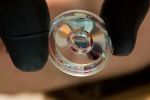Making Skin for Robots
Like it or not, the day is coming when we’ll live side by side with humanoids. But although most modern robots can grip objects and avoid walls, they lack a vital quality in any companion: feeling. They don’t need to get your jokes or sense that you had a bad day, but without all-over sensors that can detect things like motion and body heat, there’s nothing to tell them that, for instance, they’re stepping on the baby.
The same technology could be applied to such things as steering wheels to measure a driver’s grip to detect drowsiness. It could also be used in electronics, creating simpler iPod controls or expanding computer screens. The fabric needs further development—Someya is still trying to figure out how to sustain softness and elasticity in the rubber without compromising conductivity—but he expects to work out the kinks and start incorporating his robot skin into humanoids within five years.
Popular Tags
SciTech
Regular Features

Featured
SciTech
Science Confirms the Obvious 2008
The findings may be no-brainers (yes, you do get sick in winter), but these studies uncover hidden truths in conventional wisdomBuilding the Real Iron Man
While audiences flood theaters this month to see the comic-book-inspired Iron Man, a real-life mad genius toils in a secret mountain lab to make the mechanical superhuman more than just a fantasy with the XOS Exoskeleton
Popular on Popsci
Most Viewed
SciTech
- I Want That On My Desk By Two Million Years Ago
- A Million Plastic Balls to Halt Carcinogens
- Video: Why Artificial Intelligence Threatens Actual Intelligence
- A Little Off the Top, S'Il Vous Plait
- Killer Peppers
- More Bad News About Plastics
- And the Ig Nobel Goes To . . .
- And the Ig Nobel Goes to . . .
- Does Science Obviate Religion?
- Can I Have My SSN Back?
Most Commented
SciTech
- Does Science Obviate Religion?
- An Issue of National Security: Obama and McCain on DARPA
- Watch Your Wallet: Phishers on the Prowl
- Wriggling Away From Cancer
- Making Skin for Robots
- Let the Record Speak: Obama and McCain Tackle Science Education
- The Science of Spinning
- Human Evolution is Coming to a Standstill
- In Case of Emergency, Breakdown
- Rent a Robotic Suit Named HAL
Most Emailed
SciTech
- Human Evolution is Coming to a Standstill
- One in Four Mammals May Soon Be Extinct
- Killer Peppers
- An Issue of National Security: Obama and McCain on DARPA
- Watch Your Wallet: Phishers on the Prowl
- Wriggling Away From Cancer
- Making Skin for Robots
- Let the Record Speak: Obama and McCain Tackle Science Education
- The Science of Spinning
- In Case of Emergency, Breakdown








